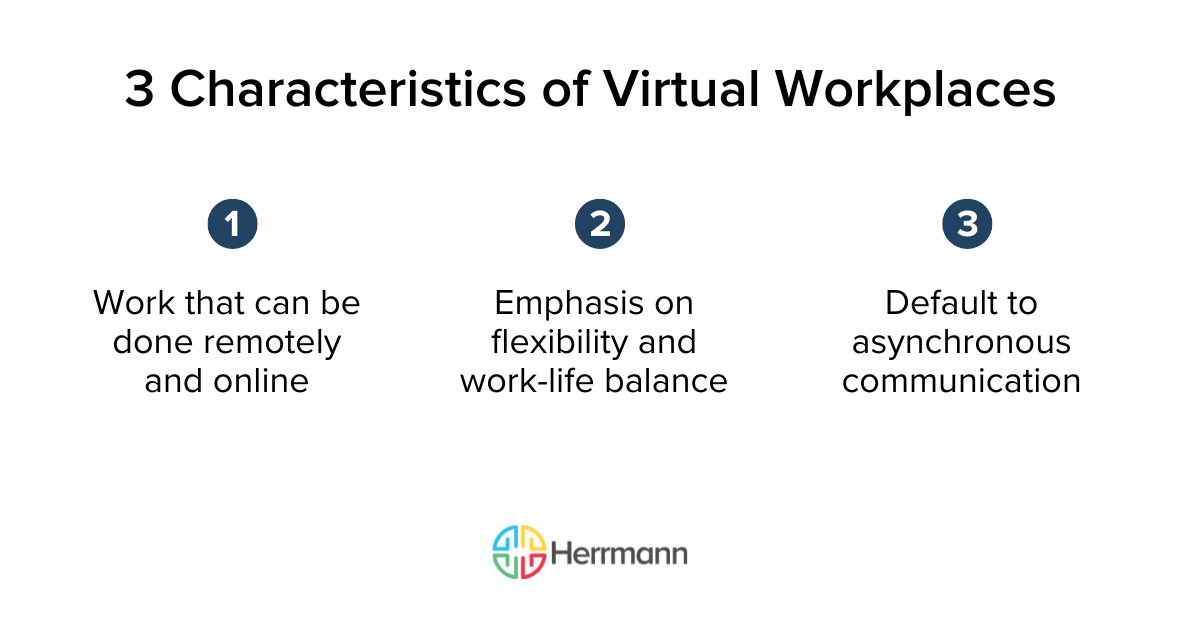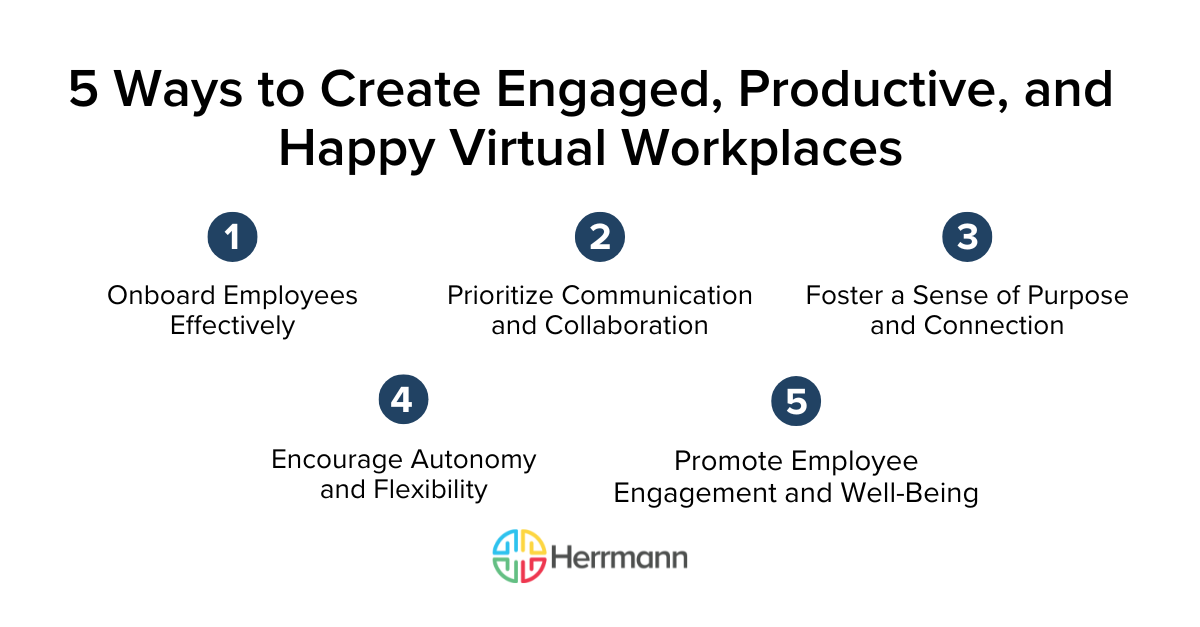The pandemic forced tens of millions of American workers to adopt remote work, often for the first time. Even as offices have reopened, millions continue working from home at least some of the time. Leaders are learning that a virtual workplace demands a different approach to onboarding, engagement, communication, and collaboration.
Workers are more than twice as likely to work remotely during regular business hours than before the COVID-19 pandemic. However, organizations are lagging when it comes to engaging with these employees. Gallup found that remote workers are least likely to feel connected to their employer’s purpose and mission.
Learn more about the benefits and challenges of virtual workplaces, how to improve engagement and productivity for virtual teams, and how Whole Brain® Thinking can foster connection and collaboration even when people aren’t in the same room together.

What Is a Virtual Workplace?
A virtual workplace is an environment where employees primarily work remotely, whether from their homes or as part of a team scattered across different job sites. In a virtual workplace, employees rely on technology to communicate, collaborate, and complete their tasks.
Key characteristics of a virtual workplace include:
- Work that can be done remotely and online: Virtual workplaces emphasize work employees can complete from anywhere with an internet connection.
- Emphasis on flexibility and work-life balance: Virtual workplaces create flexibility for employees because they don’t need to commute. Many of these workplaces also allow flexible schedules and hours, providing workers hit performance metrics and goals.
- Default to asynchronous communication: Virtual workplaces heavily rely on asynchronous communication and collaboration tools, including videoconferencing, instant messaging, project management software, and cloud-based document-sharing platforms.
Notably, virtual teams predate the pandemic, whether through online work, field service, or other arrangements in which teammates are regularly dispersed. Going forward, technology and labor trends suggest that virtual work is entrenched — creating an imperative to get it right.
Benefits of Virtual Workplaces
Increased Productivity and Efficiency
Virtual workplaces can be especially effective for workers who require deep thinking to be at their best. With fewer distractions and interruptions, employees can focus on their tasks. Many virtual workers also have the flexibility to create a personalized environment that suits their needs and maximizes their productivity.
Virtual workplaces also can improve efficiency among geographically dispersed teams that need to collaborate. They can instantly communicate about tasks, challenges, and processes. Likewise, companies with virtual workplaces can save money on travel and reduce employee disruption by having video-based meetings.
Cost Savings and Reduced Commuting
Some research suggests that fully remote work is less productive on average. But it’s also less expensive because companies save on real estate and associated expenses, such as utilities, office supplies and equipment, and maintenance.
Employers can reduce spending on office-related perks and benefits, such as transportation subsidies and food. The total cost of labor might even decline over time if employers don’t have to pay premiums for hiring in some geographic regions. Those funds can be redirected toward other business priorities.
Meanwhile, employees benefit from reduced commuting costs, including transportation expenses and parking fees. This saves them time and money while reducing the environmental impact of commuting.
Easier Time Hiring Quickly and Effectively
Sign up to our newsletter for the latest insights
Virtual work creates the opportunity to build teams across various geographies, backgrounds, cultures, and experiences, fostering a more inclusive and diverse workforce. Quality of hire can increase, creating a competitive edge in today's globalized world.
Virtual workplaces also make scaling up easier because you don’t need to figure out where to put new hires. This can be especially helpful when expanding to new geographies — you can get a head start with remote workers even if you intend to establish a physical office space.
Higher Engagement and Work-Life Balance
Effective virtual workplaces can increase employee engagement and happiness. While Gallup’s 2023 research found that remote employees are increasingly disconnected, they remain eight percentage points more engaged than on-site employees.
Other research points to the benefits of well-run virtual workplaces. A 2022 Zapier study found that 91% of workers said remote and flexible arrangements contributed to happiness at work. That same study found that 96% of workers said work-life balance influences workplace happiness.
Virtual workplaces can, at their best, create flexibility for employers to manage their personal and professional lives without sacrificing responsibilities in either realm. While work-life balance is an ongoing challenge, flexibility gives employees agency, which can reduce stress and burnout. When employees aren’t burning out, they’re more productive — and less likely to leave or resort to quiet quitting.
Challenges of Virtual Workplaces
Virtual workplaces have their challenges, including resistance from workers and leaders. Here are some common challenges to know about.
Barriers to Communication and Collaboration
The pandemic forced millions of in-office workers to change their work habits overnight, even if only temporarily. In fact, 56% of employees surveyed by Buffer in 2022 said they had to adjust how they communicated and collaborated.
Without face-to-face interactions, remote teams can struggle to effectively communicate and build relationships. Miscommunication can occur because of a lack of verbal cues, leading to misunderstandings, mistakes, and delays. Videoconferencing, chat platforms, and other digital tools can help, but they don’t necessarily mimic in-person interactions.
While virtual workplaces empower teams to work from anywhere and collaborate across geographies and time zones, this also can be a disadvantage for coordinating team meetings and other check-ins. If employees are involved in sequential work dependent on a co-worker’s efforts, time differences can cause delays and conflict.
Potential for Isolation and Disengagement
Remote work can sometimes lead to feelings of isolation and disengagement among employees, especially if they aren’t supported by their managers and the broader company culture. Employees in virtual workplaces can struggle to generate casual interactions, as most virtual communication is asynchronous or scheduled via meetings.
This isn’t a hypothetical problem: The Buffer survey found that 52% of newly remote employees feel less connected to their colleagues, and only 18% feel more connected. Employees who feel isolated or disengaged are at risk of lower morale, reduced collaboration, and less effective work results.
Imbalances Between Work and Personal Life
Virtual workplaces with flexible working arrangements can be a boon for employees’ work-life balance, especially those with nonstandard schedules or significant personal commitments.
However, ineffective virtual teams can harm work-life balance and add stress. Remote employees may find it challenging to establish boundaries and separate their work and personal lives, which can result in burnout and decreased well-being. Employees who struggle with time management or benefit from office structures can struggle to acclimate to a virtual workplace where the responsibility to stay on task lies with them.
Hurdles With Technology
Virtual workplaces depend on technology, which can be challenging for employees who struggle with tech, lack the right equipment, or can’t access IT support when needed. For some employees in certain geographies, reliable high-speed internet access is a foundational challenge.
Another challenge for virtual teams is cybersecurity and data privacy, especially when employees use personal devices on unsecured networks without a virtual private network (VPN) or other security measures.
Employees get frustrated when they struggle with technology or feel unsupported. This can reduce their engagement, job satisfaction, and output — especially if they don’t have the tools to do their jobs.

5 Ways to Create Engaged, Productive, and Happy Virtual Workplaces
Effective virtual workplaces must engender productivity without harming employee engagement or satisfaction. If you fail on the latter points, you’ll eventually see reduced productivity through employee disengagement, turnover, and loss of key knowledge. Here are some ways leaders can create effective virtual workplaces that employees enjoy.
Onboard Employees Effectively
Onboarding is essential in any organization, especially when adding new hires to a virtual workplace or helping a formerly on-site employee transition to remote work.
Communication is crucial: Ensure employees understand how your virtual workplace prefers to work — policies, processes, software and hardware, and more. Provide the necessary tools, equipment, and training so they can access all the technology and tools your employees use daily.
Encourage team members to reach out and welcome new employees, helping them feel connected and supported from the start. And remember that onboarding isn’t a one-day deal. Remote onboarding can take 90 days or more.
Prioritize Communication and Collaboration
Emphasizing the importance of communication and collaboration isn’t enough. Virtual workplaces must be explicit about the who, what, when, where, and why.
Make sure virtual workers understand your organization’s preferences for communication frequency, response times, and availability. Develop communication decision trees and processes that help employees determine how to communicate in the moment — and to whom.
Encourage transparency and mutual respect, creating an environment where employees feel comfortable openly sharing their thoughts, concerns, and ideas. Provide guidelines for virtual meetings, including team meeting agendas and ideas for how everyone can contribute.
Foster a Sense of Purpose and Connection
Instilling purpose in a virtual workplace starts at the top, with leaders communicating the organization's mission, vision, and values.
At the manager level, continuously help employees see how their work contributes to the larger picture while providing feedback on the quality of their work and how they can continue to improve.
At the team level, Encourage virtual team-building activities to foster connection and help employees get to know each other better. These can be simple activities — virtual happy hours or coffee breaks, online games, or ice breakers within team meetings. When employees get more comfortable interacting with each other in a relaxed setting, they’re more likely to seek each other out to collaborate on work-related projects.
Encourage Autonomy and Flexibility
While every business has distinct needs, look to offer flexibility in work hours and schedules whenever possible, especially when such accommodations allow workers to show up at their best without worrying about other matters.
Encourage employees to focus on achieving results rather than logging hours, promoting a results-oriented work culture where employees are evaluated based on their outcomes and contributions. This also can reduce the feeling of being on the clock 24/7; employees can step away without worrying when they have completed their job duties.
Promote Employee Engagement and Well-Being
Employee engagement has been strong among remote workers in recent years, but Gallup’s findings suggest that virtual workers feel disconnected, which could be a harbinger of an engagement crisis.
Leaders can counter this in numerous ways, including being vocal about the value of virtual workplaces as an equal to any other arrangement. Recognize and reward employee achievements, making sure that they feel appreciated for their hard work. Encourage employees to highlight each other’s successes, creating closer ties and helping everyone see how their work is interconnected.
Support work-life balance and mental health by encouraging employees to take breaks, set boundaries, and prioritize self-care. Provide robust mental health and well-being benefits, such as access to counseling services or wellness programs. Additionally, seek employee feedback regularly to understand whether the virtual work environment meets their needs — or if it’s contributing to disengagement and low productivity.
.jpeg?width=700&height=648&name=Asset%203%20Large%20(1).jpeg)
Using Whole Brain® Thinking in Virtual Workplaces
Virtual workplaces succeed when employees feel valued, can contribute their ideas, and believe they can connect and collaborate with their colleagues. These attributes align with our Whole Brain® Thinking methodology, a science-backed framework for helping individuals, teams, and organizations understand and harness their cognitive diversity.
Cognitive diversity recognizes that different people think differently, just as different people have different racial, ethnic, and cultural backgrounds and different lived experiences and opinions. Moreover, cognitive diversity reflects people's differences in how they think.
The Whole Brain® Thinking framework consists of four quadrants:
- Analytical (Blue): Logical, analytical, fact-based, quantitative
- Practical/Structural (Green): Organized, sequential, planned, detailed
- Relational (Red): Interpersonal, empathetic, kinesthetic, emotional
- Experimental/Innovative (Yellow): Holistic, experimental, integrating, synthesizing
Everyone has a stronger preference for one or two of these quadrants, but we possess the ability to excel in all four. We might just need to stretch more in certain areas.
Whole Brain® Thinking can be a powerful approach for leaders of virtual workplaces. Here are some tips inspired by advice from Ben Snyder, principal at Breeze and former CEO of Systemation.
Sweat the Details
This classic Practical (Green) activity can go a long way toward alleviating employee concerns, especially for people new to a virtual workplace or when you’re overhauling processes. Employers can assuage immediate concerns by making sure employees have all the equipment they need to work remotely, including a computer and office furniture.
Take advantage of technology to keep people connected: Use Slack, Microsoft Teams, and other chat platforms as a virtual water cooler where employees can build connections and interpersonal relationships. Whether it’s a salesperson recapping a great call or someone posting what they’ve got on deck for the day, this keeps people engaged and tapped into what’s going on, regardless of whether they have a strong Relational (Red) preference.
Prepare Your Managers
Managers and employees should have regular conversations regardless of the workplace setting. However, managers in virtual workplaces can become distracted by meetings and their own work and communicate very little with their people outside of formal meetings. Conversations become rote and lack emotional connection.
If managers are used to managing people by walking around (the kinesthetic part of Red thinking), they will need to develop new management and engagement strategies. Help managers tap into their Structural (Green) thinking to develop processes and workflows that work for them in a virtual setting. Encourage your Yellow thinkers to imagine the possibilities of shifting this mindset, and connecting on a deeper level with their employees.
Recognize That Change Affects Everyone Differently
Whole Brain® Thinking recognizes that no two people think exactly the same in every situation — including change management situations. Embracing a virtual workplace will require some level of change for nearly every employee — especially those hired in an office setting.
Some will love the new setup, but others will miss the day-to-day interaction and the hum and background noise of a busy office. It’s up to leaders to take proactive steps that ensure everyone feels comfortable with the change.
Don’t Assume One Work Style Fits All
Employees should be encouraged to find the right conditions and set up boundaries to be most productive and efficient. For some, this may mean getting up, showering, and getting dressed before signing on. Others may wake up energized to plow through a project right away.
This flexibility allows employees to tap into any combination of Whole Brain® Thinking preferences. Analytical (Blue) thinkers might tackle this challenge by assessing how their productivity is affected, while Green thinkers will embrace the chance to set their own routines. Red thinkers might tailor their work style to the impact they can make on others. In contrast, Yellow thinkers might use this flexibility to change everything — dreaming of a working style they’d never be able to attempt in a traditional setting.
Many employees, of course, will mix and match these approaches. For example, employees who love the ability to focus might occasionally work from a coffee shop to be around other people or find new inspiration. Another person working at home might stagger their start time based on their personal schedule.
Encourage employees to explore — and get ideas from their colleagues. The most important thing is that they figure out what works best for them.
Stay Focused on Results
Virtual workplaces are a powerful force because they can help employees be more productive and more engaged. Make sure your structure creates those kinds of results — and resist the urge to revert to traditional practices.
“When you go virtual, people’s lives really get in the blender,” Snyder says. “If I called someone during work hours and they weren’t at their desk, I would think, well, where are they? I had to remind myself to go back to my own rules: Are they producing what I want them to produce? If they are, then that’s all that matters.”
Embrace Working in a Virtual Environment
Virtual workplaces are here to stay, and they can help companies expand their horizons, hire more widely, and deliver better results without tying themselves to outdated notions of work. That said, these outcomes don’t happen magically.
Leaders must be especially deliberate in creating the culture, processes, policies, and mindset needed to keep virtual workers engaged, productive, and happy. The good news is it’s possible, especially when you have a tool like Whole Brain® Thinking to help you recognize and elevate the cognitive diversity of your virtual workforce.
Download our guide to going remote and learn how to better lead virtual teams.


%20(1).png?width=1200&height=627&name=Featured_Image_How%20to%20Keep%20Virtual%20Workplaces%20Engaged%2c%20Productive%20and%20Happy%20(1)%20(1).png)









